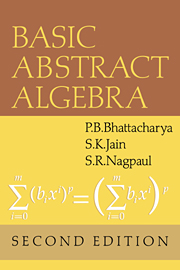Book contents
- Frontmatter
- Contents
- Preface to the second edition
- Preface to the first edition
- Glossary of symbols
- Part I Preliminaries
- Part II Groups
- Part III Rings and modules
- Chapter 9 Rings
- Chapter 10 Ideals and homomorphisms
- Chapter 11 Unique factorization domains and euclidean domains
- Chapter 12 Rings of fractions
- Chapter 13 Integers
- Chapter 14 Modules and vector spaces
- Part IV Field theory
- Part V Additional topics
- Solutions to odd-numbered problems
- Selected bibliography
- Index
Chapter 12 - Rings of fractions
Published online by Cambridge University Press: 05 June 2012
- Frontmatter
- Contents
- Preface to the second edition
- Preface to the first edition
- Glossary of symbols
- Part I Preliminaries
- Part II Groups
- Part III Rings and modules
- Chapter 9 Rings
- Chapter 10 Ideals and homomorphisms
- Chapter 11 Unique factorization domains and euclidean domains
- Chapter 12 Rings of fractions
- Chapter 13 Integers
- Chapter 14 Modules and vector spaces
- Part IV Field theory
- Part V Additional topics
- Solutions to odd-numbered problems
- Selected bibliography
- Index
Summary
Let R be a commutative ring containing regular elements; that is, elements a ∈ R such that a ≠ 0 and a is not a zero divisor. In this chapter we show that any commutative ring R with regular elements can be embedded in a ring Q with unity such that every regular element of R is invertible in Q. In particular, any integral domain can be embedded in a field. Indeed, by defining the general notion of ring of fractions with respect to a multiplicative subset S, we obtain a ring Rs such that there is a canonical homomorphism from R to Rs. The conditions under which a noncommutative integral domain can be embedded in a division ring are also discussed.
Rings of fractions
Definition.A nonempty subset S of a ring R is called a multiplicative set if for all s1, s2, we have s1s2 ∈ S. If in addition, each element of S is regular, then S is called a regular multiplicative set.
Clearly, the set of all regular elements is a regular multiplicative set. In particular, if R is an integral domain, then S = R – {0} is a regular multiplicative set.
Let R be a commutative ring and S a multiplicative set. Define a relation ∼ on R × S by (r,s) ∼ (r′,s′) if there exists s″ ∈ S such that s″(rs′ - r′s) = 0.
- Type
- Chapter
- Information
- Basic Abstract Algebra , pp. 224 - 232Publisher: Cambridge University PressPrint publication year: 1994



